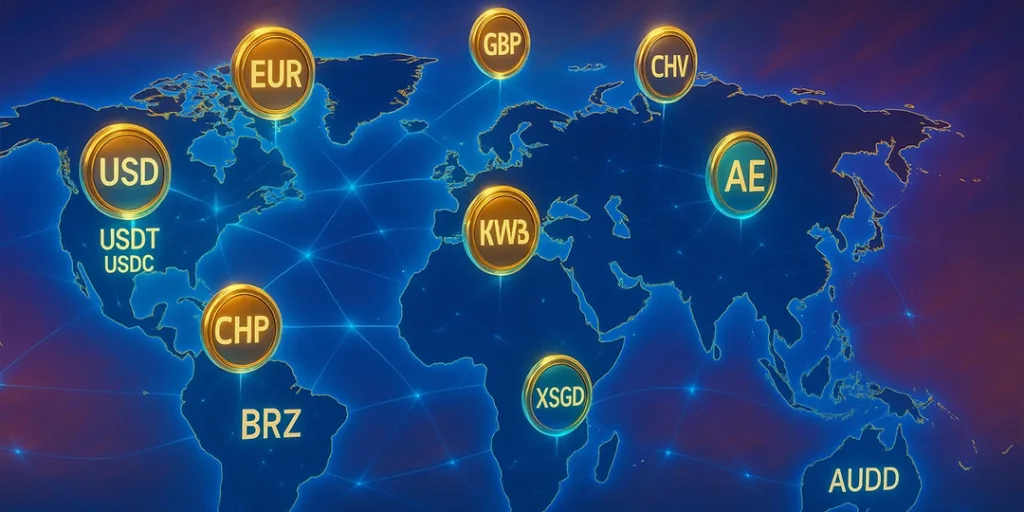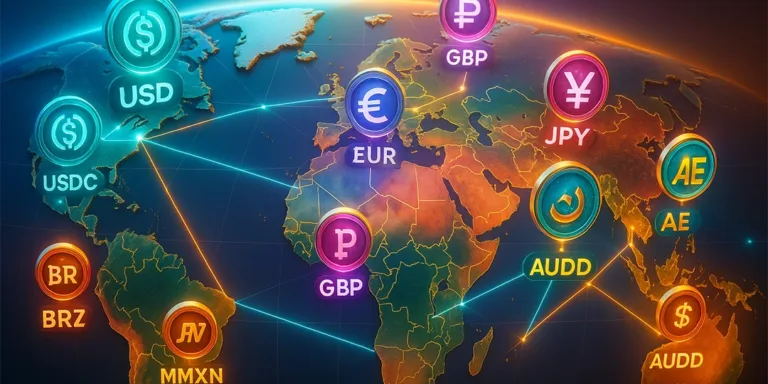We’ve watched Bitcoin and other cryptocurrencies swing thousands of dollars in a single day or even in minutes; with this in mind, you’ll understand why stablecoins exist. They’re the calm in the storm of crypto markets, designed to hold steady even when everything else goes haywire.
But in 2025, stablecoins aren’t just tied to the U.S. dollar anymore; they’re pegged to currencies from Europe to Asia, giving people worldwide a safety net against volatility and even inflation.
Today, let’s break down exactly how they work, why they matter in shaky economies, and how different regions are experimenting with AE coins and beyond.

What exactly are stablecoins?
At their simplest, stablecoins are digital tokens that mirror the value of traditional currencies. Instead of flying up and down like Bitcoin, they stay fixed, usually at 1:1 with whatever they’re pegged to.
How do they manage this? There are a few main models:
- Fiat-backed: Each coin is supported by real reserves (like USDT, USDC, or EURT).
- Crypto-backed: Held steady by over-collateralized assets (like DAI).
- Algorithmic: Controlled by supply-demand mechanisms, though these have a rocky history.
The idea is simple: you can use them to trade, save, or send money without worrying about the wild swings of other cryptocurrencies.
Why they matter in volatile times
When markets crash, traders often rush into stablecoins as a “parking lot” for value. Instead of exiting to a bank account, they move funds into coins like USDT or USDC, knowing their holdings won’t lose 20% overnight.
In countries battling inflation, stablecoins play an even bigger role. For many, holding tokens pegged to strong currencies like the U.S. dollar or euro is safer than keeping local money that loses value daily. This is where AE coins and other regional projects step in.

Stablecoins around the world: Beyond the dollar
Most people know dollar-backed stablecoins like Tether (USDT) and USD Coin (USDC). But the world of pegged tokens is expanding quickly, and today you’ll find stablecoins linked to dozens of national currencies. Here are some notable ones:
- Euro (EURT, EUROe, EURS): Popular in Europe for payments and DeFi trading.
- British Pound (GBPT, EURC’s GBP expansion): Pegged to the sterling, useful for U.K. businesses and cross-border trade.
- Japanese Yen (JPY Coin, GYEN): Aimed at boosting Japan’s digital payments ecosystem.
- Chinese Yuan (CNH₮): Offshore yuan-pegged stablecoin, tied to growing Asian markets.
- Singapore Dollar (XSGD): Backed by StraitsX, a regulated Singaporean project.
- Australian Dollar (AUDD): Pegged to the Aussie dollar, gaining traction in Asia-Pacific.
- Canadian Dollar (CADC): Used mainly in Canada’s digital payment trials.
- Brazilian Real (BRZ): A Latin American leader, pegged to Brazil’s currency for easy USD conversion.
- Mexican Peso (MMXN): Helping with remittances and local payments.
- South Korean Won (KRWb): Tied to Korea’s strong tech-driven markets.
- Dirham & Gulf-linked coins (AE coins): Pegged to the UAE dirham and Gulf currencies, designed to make regional trade and remittances smoother in the Middle East.
Each of these coins offers a digital bridge to local economies, making stablecoins more than just a dollar story.

Stablecoins and inflation: A lifeline for many
In countries where inflation eats into savings, think Argentina, Turkey, or Nigeria, stablecoins pegged to stronger currencies are often more reliable than cash in the bank. Families use them to protect salaries, businesses use them to settle trade, and workers abroad rely on them for cross-border remittances.
For example:
- In Latin America, BRZ is popular because it shields locals from the volatility of the real.
- In Asia, JPY and CNH stablecoins are helping digital trade flow faster.
- In the Middle East, AE coins pegged to the dirham offer protection from inflation while making remittances faster and cheaper.
The future of stablecoins: Global money on blockchain
Stablecoins are no longer an experiment; they’re fast becoming the backbone of crypto payments, DeFi, and even global commerce. As inflation pressures persist worldwide, expect more local-currency stablecoins to launch, bridging crypto with everyday economies.
The bigger question? How regulators will handle them. Some governments see them as competition, others as innovation. But for now, stablecoins, whether dollar, euro, yen, or AE coins, are rewriting how people think about money in volatile times.
Final word
Stablecoins work because they give people what most cryptocurrencies can’t: peace of mind. Whether you’re a trader avoiding Bitcoin’s wild swings or a worker in an inflation-hit country just trying to save your paycheck, stablecoins are proving their worth.
And in 2025, the story isn’t just about U.S. dollars anymore. From euros to yen, pesos to dirhams, and even AE coins, these tokens are showing that digital money can be stable, practical, and global all at the same time.











